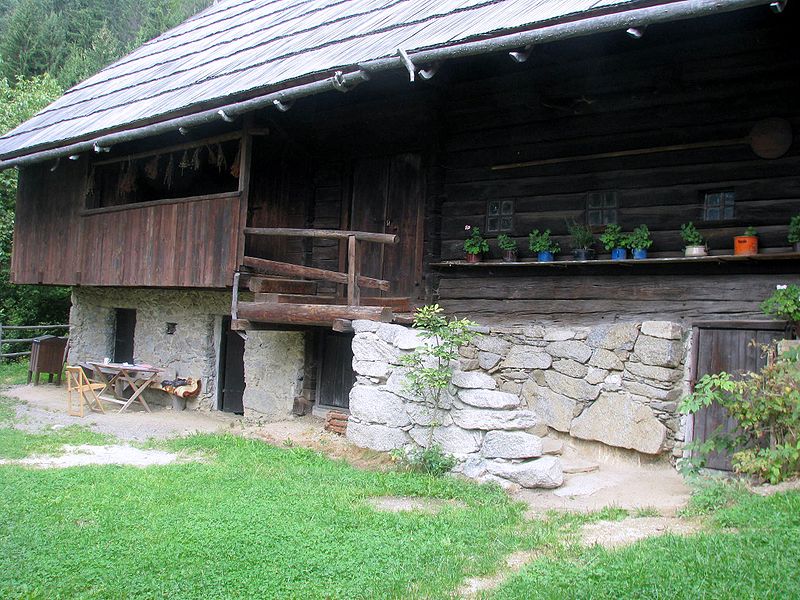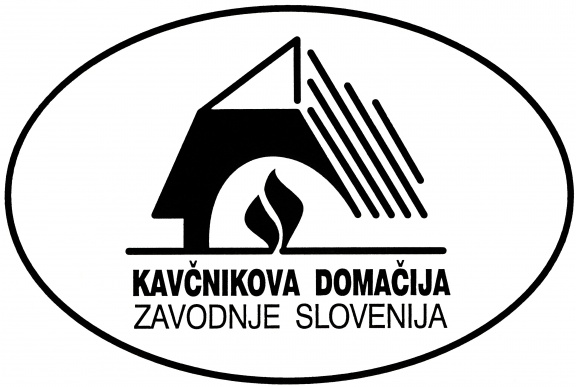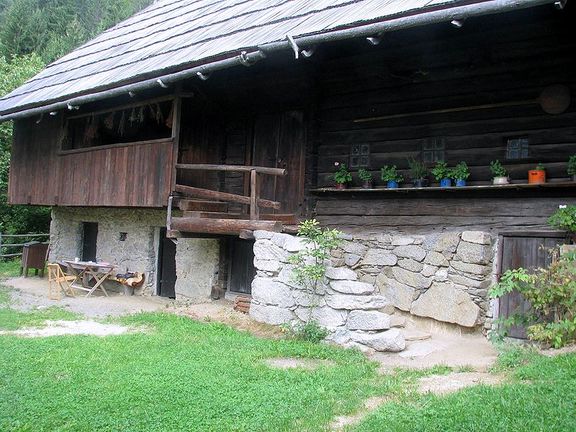Difference between revisions of "Kavčnik Homestead"
(fixed punctuation) |
(still fixing punctuation ...) |
||
| Line 25: | Line 25: | ||
}} | }} | ||
| − | The entire farm was built around its brick hearth (''dimnica''), the remaining buildings are wooden including the roofs. Around the main living quarters with a stove, there are a barn, a hayrack (''kozolec''), herb garden, tool sheds, a grape press, a field toilet ... But the most important and the oldest is the ''dimnica'' | + | The entire farm was built around its brick hearth (''dimnica''), the remaining buildings are wooden including the roofs. Around the main living quarters with a stove, there are a barn, a hayrack (''kozolec''), herb garden, tool sheds, a grape press, a field toilet ... But the most important and the oldest is the ''dimnica'' – also called ''kuhna'' (a variant of ''kuhinja'' meaning kitchen) by former inhabitants – that prevailed in northern Slovenia from the 11th until the late-18th century when, because of frequent fires, the authorities began to adopt strict measures to ban them. The smokehouse's little window with its unique sliding mechanism, and details of the wooden hinges at the entrance door to the shed, confirm that the core of the building, including the shed, probably dates from the 17th century. At that time it was the only living quarter in the Kavčnik homestead. |
By prior appointment, the museum staff can light the fire in the hearth and visitors may also roast apples on the open fire, providing a truly authentic experience of the simplicity of life in the past. Although the smoke hanging in the air may cause visitors to rethink their romantic impressions of the past when it starts to aggravate their eyes and lungs, a visit to the Kavčnik Homestead provides a rich and bona fide experience of Slovenian cultural history. | By prior appointment, the museum staff can light the fire in the hearth and visitors may also roast apples on the open fire, providing a truly authentic experience of the simplicity of life in the past. Although the smoke hanging in the air may cause visitors to rethink their romantic impressions of the past when it starts to aggravate their eyes and lungs, a visit to the Kavčnik Homestead provides a rich and bona fide experience of Slovenian cultural history. | ||
Revision as of 15:23, 6 December 2010
The entire farm was built around its brick hearth (dimnica), the remaining buildings are wooden including the roofs. Around the main living quarters with a stove, there are a barn, a hayrack (kozolec), herb garden, tool sheds, a grape press, a field toilet ... But the most important and the oldest is the dimnica – also called kuhna (a variant of kuhinja meaning kitchen) by former inhabitants – that prevailed in northern Slovenia from the 11th until the late-18th century when, because of frequent fires, the authorities began to adopt strict measures to ban them. The smokehouse's little window with its unique sliding mechanism, and details of the wooden hinges at the entrance door to the shed, confirm that the core of the building, including the shed, probably dates from the 17th century. At that time it was the only living quarter in the Kavčnik homestead.
By prior appointment, the museum staff can light the fire in the hearth and visitors may also roast apples on the open fire, providing a truly authentic experience of the simplicity of life in the past. Although the smoke hanging in the air may cause visitors to rethink their romantic impressions of the past when it starts to aggravate their eyes and lungs, a visit to the Kavčnik Homestead provides a rich and bona fide experience of Slovenian cultural history.
See also
External links
 The entrance of Kavčnik Homestead, a museum of folk architecture with the core of the building -the smoke house - dating from circa 17th century. +
The entrance of Kavčnik Homestead, a museum of folk architecture with the core of the building -the smoke house - dating from circa 17th century. +



